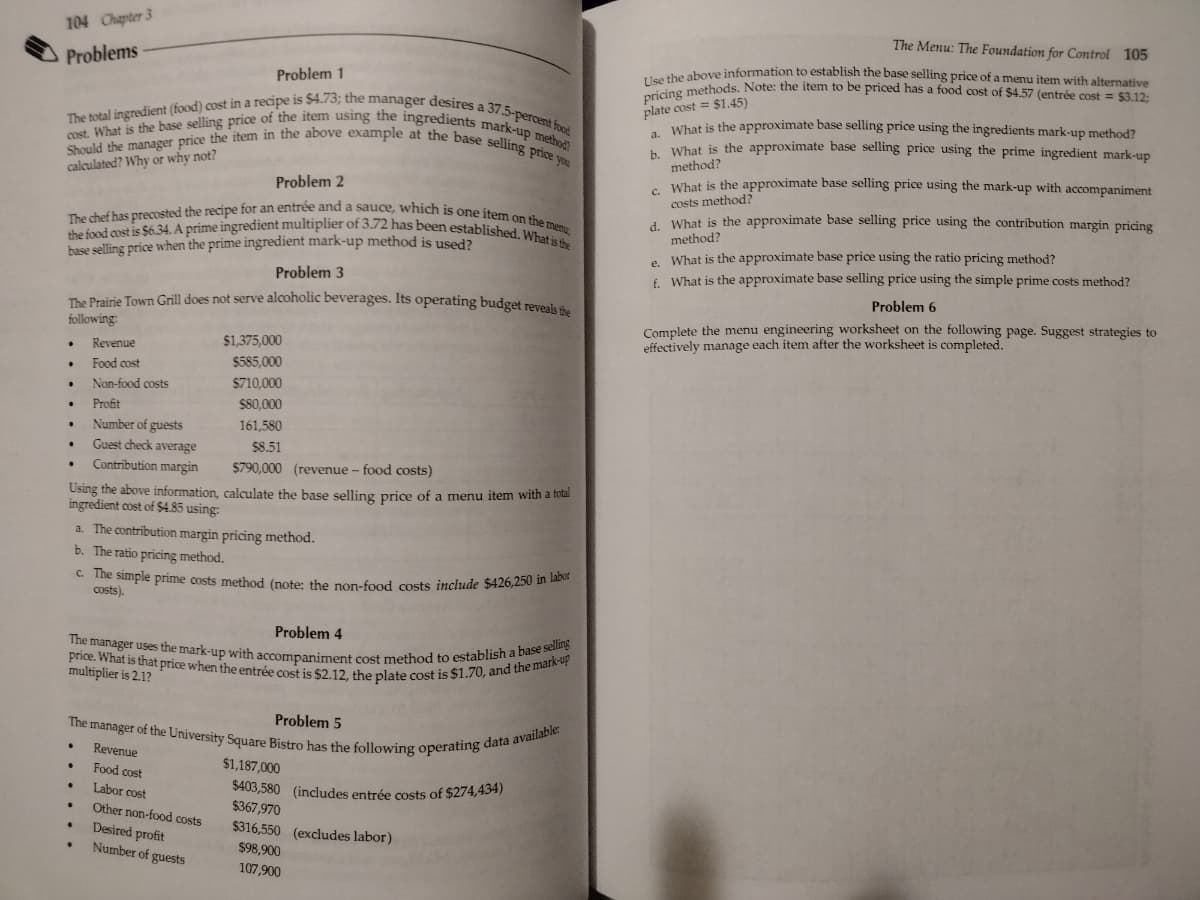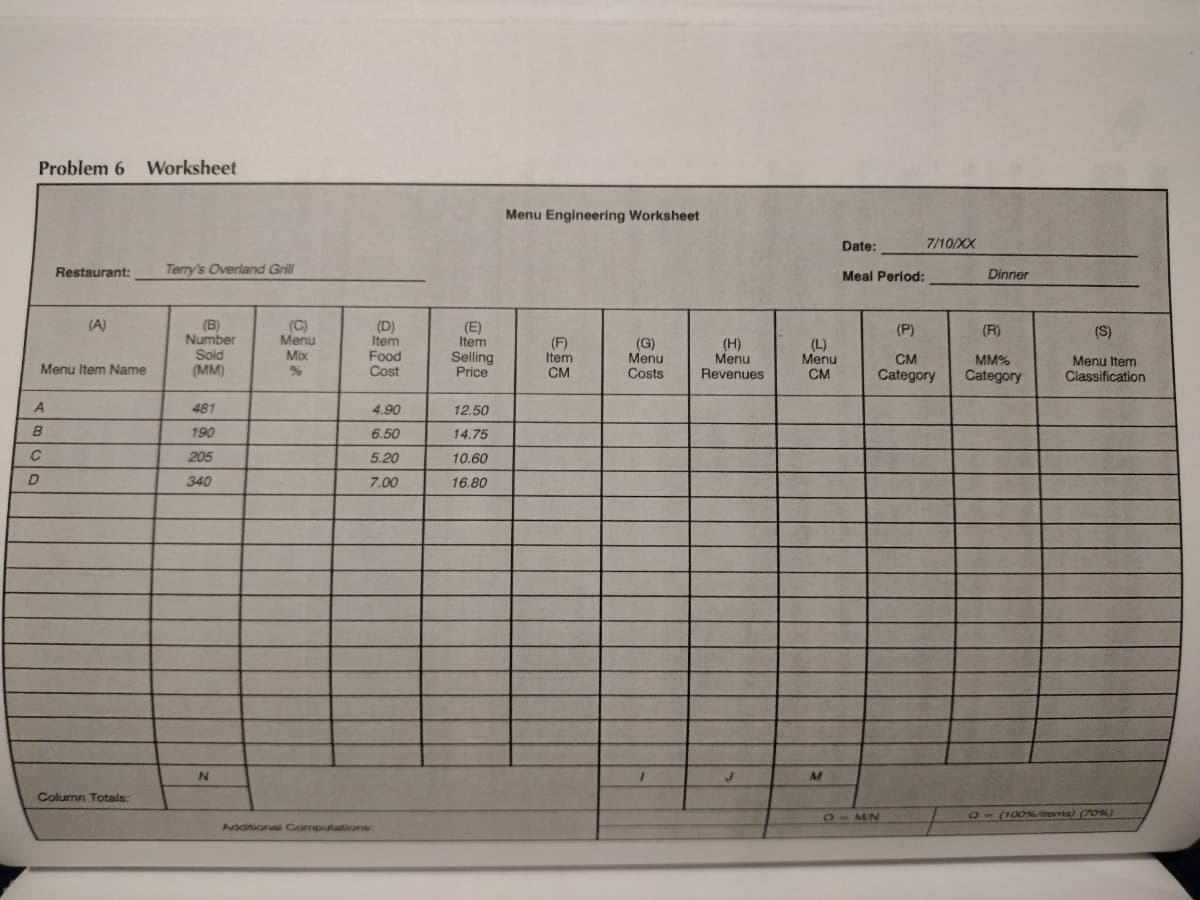The total ingredient (food) cost in a recipe is $4.73; the manager desires a 37.5-percent food cost. What is the base selling price of the item using the ingredients mark-up method Should the manager price the item in the above example at the base selling price you calculated? Why or why not? Problem 2
The total ingredient (food) cost in a recipe is $4.73; the manager desires a 37.5-percent food cost. What is the base selling price of the item using the ingredients mark-up method Should the manager price the item in the above example at the base selling price you calculated? Why or why not? Problem 2
Essentials of Economics (MindTap Course List)
8th Edition
ISBN:9781337091992
Author:N. Gregory Mankiw
Publisher:N. Gregory Mankiw
Chapter12: The Cost Of Production
Section: Chapter Questions
Problem 5PA
Related questions
Question
Do all 6 problems on pages 104 & 105, use the blank engineering worksheet for problem 6.

Transcribed Image Text:104 Chapter 3
Problems
Problem 1
The total ingredient (food) cost in a recipe is $4.73; the manager desires a 37.5-percent food
cost. What is the base selling price of the item using the ingredients mark-up method
Should the manager price the item in the above example at the base selling price you
calculated? Why or why not?
Problem 2
The chef has precosted the recipe for an entrée and a sauce, which is one item on the menu,
the food cost is $6.34. A prime ingredient multiplier of 3.72 has been established. What is the
base selling price when the prime ingredient mark-up method is used?
Problem 3
The Prairie Town Grill does not serve alcoholic beverages. Its operating budget reveals the
following:
Revenue
Food cost
Non-food costs
Profit
Number of guests
Guest check average
Contribution margin
$1,375,000
$585,000
$710,000
$80,000
161,580
$8.51
$790,000 (revenue - food costs)
Using the above information, calculate the base selling price of a menu item with a total
ingredient cost of $4.85 using:
a. The contribution margin pricing method.
b. The ratio pricing method.
c. The simple prime costs method (note: the non-food costs include $426,250 in labor
costs).
Problem 4
The manager uses the mark-up with accompaniment cost method to establish a base selling
price. What is that price when the entrée cost is $2.12, the plate cost is $1.70, and the mark-up
multiplier is 2.1?
Problem 5
The manager of the University Square Bistro has the following operating data available:
Revenue
Food cost
Labor cost
Other non-food costs
Desired profit
Number of guests
$1,187,000
$403,580 (includes entrée costs of $274,434)
$367,970
$316,550 (excludes labor)
$98,900
107,900
The Menu: The Foundation for Control 105
Use the above information to establish the base selling price of a menu item with alternative
pricing methods. Note: the item to be priced has a food cost of $4.57 (entrée cost = $3.12;
plate cost $1.45)
a. What is the approximate base selling price using the ingredients mark-up method?
b. What is the approximate base selling price using the prime ingredient mark-up
method?
What is the approximate base selling price using the mark-up with accompaniment
costs method?
d. What is the approximate base selling price using the contribution margin pricing
method?
e. What is the approximate base price using the ratio pricing method?
f. What is the approximate base selling price using the simple prime costs method?
Problem 6
Complete the menu engineering worksheet on the following page. Suggest strategies to
effectively manage each item after the worksheet is completed.

Transcribed Image Text:Problem 6 Worksheet
Restaurant: Terry's Overland Grill
A
B
C
D
(A)
Menu Item Name
Column Totals:
(B)
Number
Sold
(MM)
481
190
205
340
N
Menu
Mix
%
(D)
Item
Food
Cost
4.90
6.50
5.20
7.00
Additional Computations:
(E)
Item
Selling
Price
12.50
14.75
10.60
16.80
Menu Engineering Worksheet
(F)
Item
CM
(G)
Menu
Costs
1
(H)
Menu
Revenues
J
(L)
Menu
CM
M
Date:
Meal Period:
2-M/N
7/10/XX
(P)
CM
Category
Dinner
(R)
MM%
Category
(S)
Menu Item
Classification
Q- (100%/items) (70 %)
Expert Solution
This question has been solved!
Explore an expertly crafted, step-by-step solution for a thorough understanding of key concepts.
This is a popular solution!
Trending now
This is a popular solution!
Step by step
Solved in 3 steps

Knowledge Booster
Learn more about
Need a deep-dive on the concept behind this application? Look no further. Learn more about this topic, economics and related others by exploring similar questions and additional content below.Recommended textbooks for you

Essentials of Economics (MindTap Course List)
Economics
ISBN:
9781337091992
Author:
N. Gregory Mankiw
Publisher:
Cengage Learning

Essentials of Economics (MindTap Course List)
Economics
ISBN:
9781337091992
Author:
N. Gregory Mankiw
Publisher:
Cengage Learning